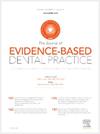SAFETY AND EFFICACY OF DEXMEDETOMIDINE-KETAMINE COMBINATION VS DEXMEDETOMIDINE ALONE FOR PEDIATRIC DENTAL SEDATION: A SYSTEMATIC REVIEW AND META-ANALYSIS
IF 4
4区 医学
Q1 DENTISTRY, ORAL SURGERY & MEDICINE
引用次数: 0
Abstract
Background
Dexmedetomidine (D) and ketamine are widely used for pediatric dental sedation, each presenting unique benefits and potential adverse effects. Combining these agents, referred to as DK, was suggested to provide a balanced approach to pediatric sedation. This is the first systematic review and meta-analysis to evaluate the efficacy and safety of DK versus dexmedetomidine alone in pediatric dental procedures.
Methods
A systematic search was conducted in PubMed, Scopus, Web of Science, Embase, and CENTRAL, identifying randomized controlled trials (RCTs) comparing DK to D alone. Eligible studies were screened, and data were extracted following PRISMA guidelines. Meta-analyses were conducted using random effects models through RevMan software.
Results
Five studies involving 308 pediatric patients were included. Meta-analysis showed no significant difference in onset of sedation time (MD = −0.02 minutes; 95% CI = [−3.27, 3.23]; P = .99; I² = 29%), duration of sedation (MD = −7.39 minutes; 95% CI = [−21.69, 6.91]; P = .31; I² = 95%), or recovery time (MD = 4.71 minutes; 95% CI = [−12.80, 22.23]; P = .60; I² = 92%). Analysis of Anxiety and pain scores favored DK (SMD = −0.67; 95% CI = [−1.20, −0.14]; P = .01; I² = 35%), (MD = −1.11; 95% CI = [−2.04, −0.19]; P = .02; I² = 20%), respectively. Adverse events, including bradycardia, hypotension, and agitation, vomiting, nausea showed no significant differences between groups.
Conclusion
The combination of DK does not offer significant advantages over dexmedetomidine alone for pediatric dental sedation. However, DK showed a moderate reduction in anxiety and pain with a favorable safety profile, suggesting it is a viable option in clinical practice.
右美托咪定-氯胺酮联合与单独右美托咪定用于小儿牙科镇静的安全性和有效性:一项系统评价和荟萃分析
右美托咪定(D)和氯胺酮被广泛用于儿科牙科镇静,各自具有独特的益处和潜在的不良反应。联合这些药物,被称为DK,被建议提供一个平衡的方法,以儿童镇静。这是第一个系统评价和荟萃分析,以评估DK与单独使用右美托咪定在儿童牙科手术中的有效性和安全性。方法系统检索PubMed、Scopus、Web of Science、Embase、CENTRAL等数据库,找出比较丹参与丹参的随机对照试验(rct)。筛选符合条件的研究,并按照PRISMA指南提取数据。采用随机效应模型,通过RevMan软件进行meta分析。结果纳入5项研究,涉及308例儿科患者。meta分析显示,两组患者镇静起始时间无显著差异(MD = −0.02分钟;95% ci = [−3.27,3.23];P = 获得;I² = 29%)、镇静时间(MD = −7.39分钟;95% ci = [−21.69,6.91];P = 。31;I² = 95%)或恢复时间(MD = 4.71分钟;95% ci = [−12.80,22.23];P = .60;我² = 92%)。焦虑和疼痛评分偏向DK (SMD = −0.67;95% ci = [−1.20,−0.14];P = . 01;我² = 35%)、(MD = −1.11;95% ci = [−2.04,−0.19];P = .02点;我² = 20%),分别为。不良事件,包括心动过缓、低血压、躁动、呕吐、恶心在两组间无显著差异。结论与单用右美托咪定相比,联合应用DK在小儿牙科镇静方面没有明显优势。然而,DK显示出焦虑和疼痛的适度减少,并具有良好的安全性,这表明它在临床实践中是一种可行的选择。
本文章由计算机程序翻译,如有差异,请以英文原文为准。
求助全文
约1分钟内获得全文
求助全文
来源期刊

Journal of Evidence-Based Dental Practice
DENTISTRY, ORAL SURGERY & MEDICINE-
CiteScore
6.00
自引率
16.70%
发文量
105
审稿时长
28 days
期刊介绍:
The Journal of Evidence-Based Dental Practice presents timely original articles, as well as reviews of articles on the results and outcomes of clinical procedures and treatment. The Journal advocates the use or rejection of a procedure based on solid, clinical evidence found in literature. The Journal''s dynamic operating principles are explicitness in process and objectives, publication of the highest-quality reviews and original articles, and an emphasis on objectivity.
 求助内容:
求助内容: 应助结果提醒方式:
应助结果提醒方式:


